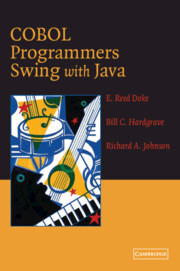Book contents
- Frontmatter
- Contents
- Preface
- Introduction
- Chapter 1 Why You Should Learn Java
- Chapter 2 An Introduction to Object-Oriented Programming
- Chapter 3 Java Structure
- Chapter 4 Defining Data
- Chapter 5 Computation
- Chapter 6 Decision Making
- Chapter 7 Loops
- Chapter 8 Arrays
- Chapter 9 Data Access
- Chapter 10 Graphical User Interfaces
- Chapter 11 Object-Oriented Development Issues
- Glossary
- Index
Chapter 6 - Decision Making
Published online by Cambridge University Press: 26 August 2009
- Frontmatter
- Contents
- Preface
- Introduction
- Chapter 1 Why You Should Learn Java
- Chapter 2 An Introduction to Object-Oriented Programming
- Chapter 3 Java Structure
- Chapter 4 Defining Data
- Chapter 5 Computation
- Chapter 6 Decision Making
- Chapter 7 Loops
- Chapter 8 Arrays
- Chapter 9 Data Access
- Chapter 10 Graphical User Interfaces
- Chapter 11 Object-Oriented Development Issues
- Glossary
- Index
Summary
OBJECTIVES
In this chapter you will study:
Conditions;
Logical operators;
if … else structure;
Case structure;
Java switch; and
Java break.
In this chapter you will learn how to implement the selection and case structure using Java. You will see how to write if and switch statements. Java and COBOL if statements are very similar and therefore straightforward. However, switch is a distant cousin of the COBOL EVALUATE verb and has some similarities, but it also has many important differences, which will be discussed and illustrated in this chapter.
We will first examine the Java logical operators, conditions, and the if statement. This discussion includes the emulation of COBOL condition names using Java. Next we present the switch statement and explain its use. The chapter concludes with the development of a new method, computeServiceCharge(), for Checking Account. This method is first written using nested if statements, then written again using switch.
The chapter assumes you understand the following:
COBOL
Condition names
Logical operators
IF—ELSE—END—IF
EVALUATE
CONTINUE
Java
OO concepts (Chapter 2)
Java program structure (Chapter 3)
Defining data (Chapter 4)
Computation (Chapter 5)
SERVICE CHARGES AT COMMUNITY NATIONAL BANK
The Community National Bank system computes a service charge for each checking account each month.
- Type
- Chapter
- Information
- COBOL Programmers Swing with Java , pp. 108 - 128Publisher: Cambridge University PressPrint publication year: 2004



